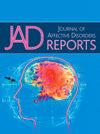难治性抑郁症的杏仁核分区域功能连接
Q3 Psychology
引用次数: 0
摘要
研究背景:几乎50%的抑郁症患者存在治疗耐药性,杏仁核功能障碍被广泛涉及。fMRI研究通常侧重于识别整个而不是单个分区域杏仁核功能连接,但这种方法以及队列异质性可能导致结果不一致。本研究使用高分辨率3T功能磁共振成像数据来调查分区域的改变,这些改变可能区分治疗抵抗者与健康个体和对治疗有反应的抑郁症患者。方法对35例难治性抑郁症(TRD)、38例健康对照(HC)和35例治疗敏感(TSD)患者进行静息状态功能磁共振成像(fMRI)分析。对双侧三个主要亚区(基底外侧、中央内侧和浅表)以及整个杏仁核进行了基于种子的功能连通性分析,并进行了组间比较。结果我们发现TRD的右侧基底外侧杏仁核亚区与两组相比存在连通性差异。与HC相比,TRD患者与右侧梭状回的连通性较低,而与TSD相比,与左侧额下回的连通性较高。没有发现整个杏仁核或任何其他双侧次区域的连通性差异。局限性适度的样本量和横断面研究设计是局限性。功能连接改变与治疗抵抗之间的因果关系尚不能确定。结论右基底外侧亚区连通性改变是TRD的显著特征。这些改变可能是TRD特征的情绪处理和社会功能严重受损的基础。这些结果强调需要进一步研究杏仁核亚区在抑郁症中的功能作用。本文章由计算机程序翻译,如有差异,请以英文原文为准。
Amygdala subregional functional connectivity in treatment-resistant depression
Background
Treatment resistance impacts almost 50 % of depression patients, with amygdala dysfunction being widely implicated. fMRI studies have typically focussed on identifying whole rather than individual subregional amygdala functional connectivity but this approach, together with cohort heterogeneity, is likely contributing to inconsistent results. This study used high resolution 3T fMRI data to investigate subregional alterations that may differentiate treatment-resistant cohorts from healthy individuals and depressed patients who respond to treatment.
Methods
Resting-state fMRI data were obtained in 35 participants diagnosed with Treatment-Resistant Depression (TRD), 38 healthy control participants (HC), and 35 treatment-sensitive participants (TSD). Seed-based functional connectivity analyses of three main subregions bilaterally (laterobasal, centromedial and superficial), as well as the whole amygdala, were performed and comparisons made between groups.
Results
We found connectivity differences in the right laterobasal amygdala subregion in TRD compared to both groups. TRD patients displayed hypoconnectivity to the right fusiform gyrus relative to HC whereas hyperconnectivity to the left inferior frontal gyrus relative to TSD was identified. No connectivity differences were found for the whole amygdala or any of the other subregions bilaterally.
Limitations
Modest sample size and cross-sectional study design are limitations. A causal relationship between functional connectivity alterations and treatment resistance cannot be established.
Conclusion
Altered connectivity of the right laterobasal subregion is a distinguishing feature of TRD. These alterations may underlie severe impairments in emotion processing and social functioning that are characteristic of TRD. These results emphasise the need for further investigation of the functional role of the amygdala subregions in depression.
求助全文
通过发布文献求助,成功后即可免费获取论文全文。
去求助
来源期刊

Journal of Affective Disorders Reports
Psychology-Clinical Psychology
CiteScore
3.80
自引率
0.00%
发文量
137
审稿时长
134 days
 求助内容:
求助内容: 应助结果提醒方式:
应助结果提醒方式:


